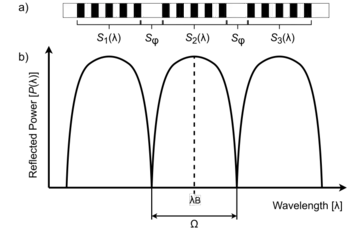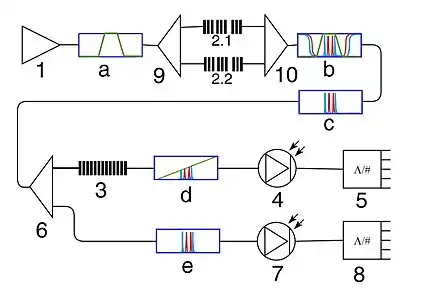An addressed fiber Bragg structure (AFBS) is a fiber Bragg grating, the optical frequency response of which includes two narrowband components with the frequency spacing between them (which is the address frequency of the AFBS) being in the radio frequency (RF) range. The frequency spacing (the address frequency) is unique for every AFBS in the interrogation circuit and does not change when the AFBS is subjected to strain or temperature variation. An addressed fiber Bragg structure can perform triple function in fiber-optic sensor systems: a sensor, a shaper of double-frequency probing radiation, and a multiplexor. The key feature of AFBS is that it enables the definition of its central wavelength without scanning its spectral response, as opposed to conventional fiber Bragg gratings (FBG), which are probed using optoelectronic interrogators. An interrogation circuit of AFBS is significantly simplified in comparison with conventional interrogators and consists of a broadband optical source (such as a superluminescent diode), an optical filter with a predefined linear inclined frequency response, and a photodetector. The AFBS interrogation principle intrinsically allows to include several AFBSs with the same central wavelength and different address frequencies into a single measurement system.

History
The concept of addressed fiber Bragg structures was introduced in 2018 by Airat Sakhabutdinov[1] and developed in collaboration with his scientific adviser, Oleg Morozov. The idea emerged from the earlier works of Morozov and his colleagues,[2][3] where the double-frequency optical radiation from an electro-optic modulator was used for the definition of the FBG central wavelength based on the amplitude and phase analysis of the beating signal at the frequency equal to the spacing between the two components of the probing radiation. This eliminates the need for scanning the FBG spectral response while providing high accuracy of measurements and reducing the system cost.[1][2] AFBS has been developed as a further step towards simplification of FBG interrogation systems by transferring the shaping of double-frequency probing radiation from the source modulator to the sensor itself.[1]
Types of AFBS
Thus far, two types of AFBS with different mechanisms of forming double-frequency radiation have been presented: 2π-FBG and 2λ-FBG.
2π-FBG
A 2π-FBG is an FBG with two discrete phase π-shifts.[4][5][6] It comprises three sequential uniform FBGs with gaps equal to one grating period between them (see Fig. 1). In the system, several 2π-FBGs must be connected in parallel so that the photodetector receives the light propagated through the structures.
2λ-FBG
A 2λ-FBG consists of two identical ultra-narrow FBGs, the central wavelengths of which are separated by an address frequency.[7][8] Several 2λ-FBGs in the system can be connected in series, so that the photodetector receives the light reflected from the structures.
Interrogation principle

Fig. 2 presents the block diagram of the interrogation system for two AFBSs (2π-FBG-type) with different address frequencies Ω1 and Ω2. A broadband light source 1 generates continuous light radiation (diagram a), which corresponds to the measurement bandwidth. The light is transmitted through the fiber-optic coupler 9, then enters the two AFBSs 2.1 and 2.2. Both AFBSs transmit two-frequency radiations that are summed into a combined radiation (diagram b) using another coupler 10. At the output of the coupler, a four-frequency radiation (diagram c) is formed, which is sent through a fiber-optic splitter 6. The splitter divides the optical signal into two channels – the measuring channel and the reference channel. In the measuring channel, an optical filter 3 with a pre-defined linear inclined frequency response is installed, which modifies the amplitudes of the four-frequency radiation into the asymmetrical radiation (diagram d). After that, the signal is sent to the photodetector 4 and is received by the measuring analog-to-digital converter (ADC) 5. The signal from the ADC is used to define the measurement information from the AFBS. In the reference channel, the signal (diagram e) is sent to the reference photodetector 7 for the optical power output control, and then it is received by the reference ADC 8. Thus, the normalization of output signal intensity is achieved, and all subsequent calculations are performed using the relations of the intensities in the measuring and reference channels.[5][6]
Assume that the response from each spectral components of AFBSs is represented by a single harmonic, then the total optical response from the two AFBSs can be expressed as:[1][4]
where Ai, Bi are the amplitudes of the frequency components of the i-th AFBS; ωi, is the frequency of the left spectral components of the i-th AFBS; Ωi is the address frequency of the i-th AFBS.
The luminous power received by the photodetector can be described by the following expression:
By narrowband filtering of the signal P(t) at the address frequencies, a system of equations can be obtained, using which the central frequencies of the AFBSs can be defined:
where Dj is the amplitude of the signal at the address frequencies Ωj, and the exponential multipliers describe the bandpass filters at the address frequencies.
References
- 1 2 3 4 Sakhabutdinov A.J. Microwave-Photonic Sensor Systems Based on Address Fiber Bragg Structures and their Application for Solving Practical Problems. D.Sc. Thesis. Kazan: Kazan National Research Technical University named after A.N. Tupolev-KAI Publ., 2018. (in Russian)
- 1 2 Morozov O.G. Symmetrical double-frequency reflectometry for the monitoring of natural and artificial media. D.Sc. Thesis. Kazan, 2004. 333 p. (in Russian)
- ↑ Ilyin, G.I.; Morozov, O.G. Single-frequency coherent radiation in two-frequency conversion method. Patent RU No. A 1338647 SU 4 G02F 1/03. Request 13.04.83; Published 20.04.2004.
- 1 2 Morozov, O.G.; Sakhabutdinov, A.J. (August 2019). "Addressed fiber Bragg structures in quasi-distributed microwave-photonic sensor systems" (PDF). Computer Optics (in Russian). 43 (4): 535–543. Bibcode:2019CoOpt..43..535M. doi:10.18287/2412-6179-2019-43-4-535-543. ISSN 2412-6179.
- 1 2 Agliullin, T. A.; Gubaidullin, R. R.; Morozov, O. G.; Zh. Sahabutdinov, A.; Ivanov, V. (March 2019). "Tire Strain Measurement System Based on Addressed FBG-Structures". 2019 Systems of Signals Generating and Processing in the Field of on Board Communications. Moscow, Russia: IEEE. pp. 1–5. doi:10.1109/SOSG.2019.8706815. ISBN 978-1-7281-0606-9. S2CID 146118643.
- 1 2 Sahabutdinov, A. Zh.; Morozov, O. G.; Agliullin, T. A.; Gubaidullin, R. R.; Ivanov, V. (March 2020). "Modeling of Spectrum Response of Addressed FBG-Structures in Load Sensing Bearings". 2020 Systems of Signals Generating and Processing in the Field of on Board Communications. Moscow, Russia: IEEE. pp. 1–4. doi:10.1109/IEEECONF48371.2020.9078659. ISBN 978-1-7281-4772-7. S2CID 216588349.
- ↑ Gubaidullin, R. R.; Sahabutdinov, A. Zh.; Agliullin, T. A.; Morozov, O. G.; Ivanov, V. (July 2019). "Application of Addressed Fiber Bragg Structures for Measuring Tire Deformation". 2019 Systems of Signal Synchronization, Generating and Processing in Telecommunications (SYNCHROINFO). Russia: IEEE. pp. 1–7. doi:10.1109/SYNCHROINFO.2019.8813908. ISBN 978-1-7281-3238-9. S2CID 201810980.
- ↑ Morozov, O G; Sakhabutdinov, A Zh; Nureev, I I; Misbakhov, R Sh (November 2019). "Modelling and record technologies of address fibre Bragg structures based on two identical ultra-narrow gratings with different central wavelengths". Journal of Physics: Conference Series. 1368 (2): 022049. Bibcode:2019JPhCS1368b2049M. doi:10.1088/1742-6596/1368/2/022049. ISSN 1742-6588.